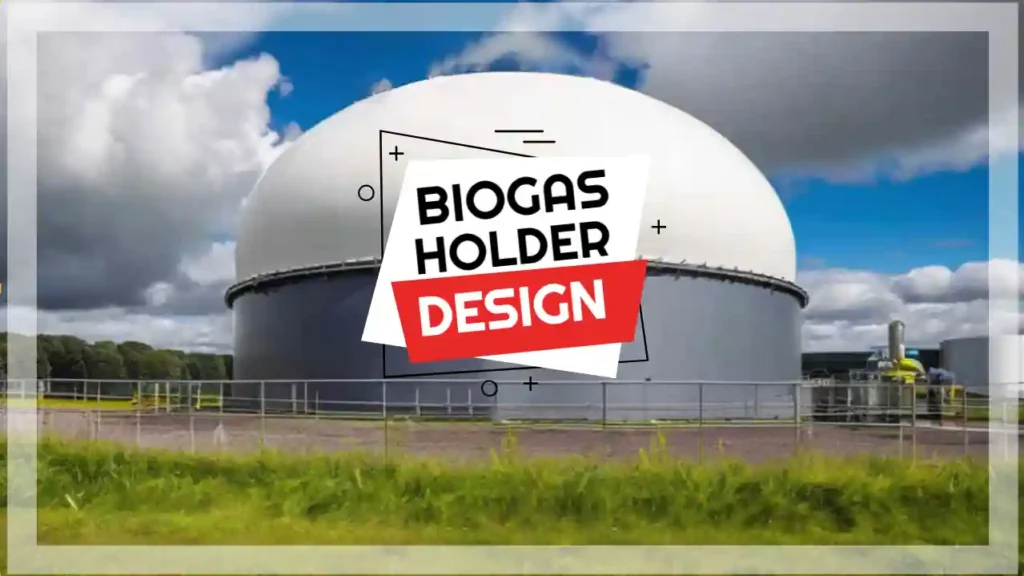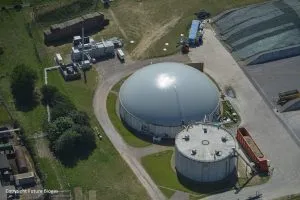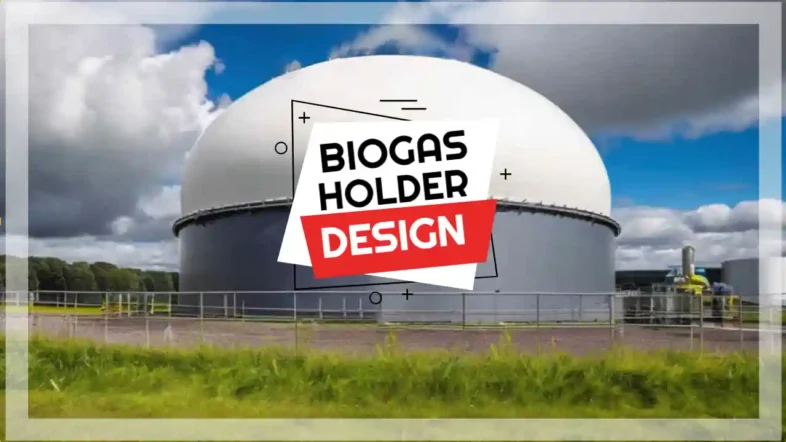Biogas Holder Design is synonymous with the term “double membrane gas holder” and the suppliers and contractors that apply this description to their biogas storage products tailor their gas holders for use on large commercial circular-walled digesters. These are by far the most common type of commercial AD plants, and most of those follow the description of mesophilic type single stage continuously stirred biogas reactors (CSTRs).
Biogas holders designed for Wastewater Treatment plants (WWTPs – “sewage works”) sludge digestion plants, while also being “mesophilic type single stage continuously stirred biogas reactors (CSTRs)“, differ from the designs discussed here. Many WWTP sludge digestion plants have a rigid fixed roof and biogas holder designs are sold as stand-alone gas storage units for those.
Similarly, dry anaerobic digestion plants (SSADs) also need biogas storage, but again, those biogas holder designs are not covered in this article, unless provided as stand-alone membrane biogas holders.
Although the size of biogas holders is considerable, they are not provided for long-term gas storage. Typically, biogas holders provide storage capacity for no more than a few hours of gas production capacity.
The gas compression in gas holders is low compared with gas grid network pressures. They would not be an economical choice for long-term storage at any AD facility. If used for that purpose the biogas holders would need to be too large to be economically justifiable.
Instead, the biogas from AD plants is used 24/7, either to run a generator feeding electricity into the electrical grid or is fed into a biogas upgrading system to make biomethane continuously.
This makes the power from biogas plants unique among mainstream renewable energy sources because the supply is not intermittent. It is an always-on supply and very valuable as baseload energy.
Biogas Holder: A Definition
A biogas holder is a short-term storage vessel designed to hold biogas produced during the anaerobic digestion process.
It comprises two flexible plastic membranes placed one over the other. The lower part acts as a sealed bag covering the space over the digester tank and is inflated from the biogas emanating from the digester substrate.
The upper portion of the dual membrane is visible as a large dome above the tank walls. It is inflated by an automatic gas pressure balancing system that allows the volume of biogas in the lower “bag” to expand and contract to accommodate variations in the biogas supply requirements downstream and balance the gas supply to the demand.

The Role and Structure of Double Membrane Biogas Holders
This type of biogas holder design is characterized by two distinct, flexible membrane layers. Here's a breakdown of its structure and function:
- Outer Membrane: This is the external layer of the biogas holder. It serves as a protective cover and is typically weather-resistant, protecting the inner membrane and the stored biogas from environmental elements such as rain, wind, and UV radiation.
- Inner Membrane: The inner membrane is the primary gas-tight layer. It directly contains the biogas and expands or contracts based on the volume of gas stored. This layer is crucial for maintaining the quality and purity of the biogas, preventing gas leaks, and ensuring safety.
- Supporting Air Space: Between the outer and inner membranes, there's a space which is often maintained at a slightly higher pressure using air. This air support system keeps the outer membrane taut and provides insulation and structural stability to the biogas holder.
- Gas Storage and Pressure Control: The biogas holder is designed to accommodate the fluctuating volumes of biogas produced during the digestion process. It can expand as biogas is produced and contract as biogas is used or removed for processing. This flexible capacity helps in managing and maintaining optimal pressure levels within the storage system.
- Safety and Operational Features: Double membrane biogas holders often come with safety features like pressure relief valves, gas detectors, and level indicators. These features are crucial for monitoring the status of the biogas, ensuring safe operation, and preventing overpressure or damage to the system.
Overall, double membrane biogas holders are a practical and efficient solution for storing biogas in anaerobic digestion plants. Their design allows for safe storage, easy maintenance, and operational flexibility, making them a popular choice in biogas production facilities.
The Need for an Emergency Flare Even When a Biogas Holder is Provided

In reality, it is not feasible to construct a biogas holder that can hold the biogas flow for longer than a few hours.
In the event of equipment failure downstream of the digester the digestion process can only be reduced but not stopped. So, even when a gas holder is present, there must be a way to vent excess biogas into the atmosphere.
Therefore, an emergency flare should be installed in every biogas plant. This will ensure that any surplus biogas is vented as carbon dioxide (CO2) rather than methane (CH4), a gas significantly more harmful to climate change.
Correcting a Common Misconception Necessary Before Starting Any Biogas Holder Design Article
To all normal purpose it is a mistake to assume (although many do) that masonry, mortar and concrete are gas-tight. They are not. The use of mortar additives to improve gas tight properties is not sufficient. Gas-tightness can only be achieved through a combination of good, careful workmanship and special coatings.
Special coatings can be applied to masonry and plaster that is strong and free of cracks, and these may be gas tight when constructed. However, masonry and plaster are stiff material which will eventually crack at some location. A coating which has been applied to such surfaces would have to be very special not to also crack. Once cracks have developed, many experts say that not even the best seal coating can render cracks permanently gas-tight thereafter.
Types of Gasholders for Biogas Plants
Floating Drum and Stand-alone and Fixed Dome
Depending on the need and the capacity, different types of biogas plants have different gasholders. Major types of the gasholders are summarised as follows:
Most floating-drum gas holders are made of 2-4 mm thick sheet steel, with the sides made of thicker material than the top to compensate for the higher degree of corrosive attack. Structural stability is provided by L-bar bracing which also serves to break up surface scum when the drum is rotated. A guide frame stabilises the gas drum and prevents it from tilting and rubbing against the masonry.
The two equally suitable and most frequently used types are:
- an internal rod & pipe guide with a fixed (concrete-embedded) cross pole (an advantageous configuration in connection with an internal gas outlet);
- external guide frame supported on three wooden or steel legs.
For either design, substantial force can be necessary to rotate the drum, especially if it is stuck in a heavy layer of floating scum. All grades of steel normally used for gas holders are susceptible to moisture-induced rusting both inside and outside. Consequently, a long service life requires proper surface protection with a corrosion protection paint.
Materials regarded as suitable alternatives to standard grades of steel are galvanised sheet metal, plastics (glass-fibre reinforced plastic (GRP), plastic sheeting) and ferro-cement with a gas-tight lining.
A fixed-dome gas holder can be either the upper part of a hemispherical digester (CAMARTEC design) or a conical top of a cylindrical digester (e.g. Chinese fixed-dome plant). In a fixed-dome plant, the gas collecting in the upper part of the dome displaces a corresponding volume of digested slurry.
Plastic Membrane Balloon or Bag Type
Gas-holders made of plastic membrane sheets welded together serve as integrated gas-holders, and in stand-alone installations on their own ground slabs.
For plastic (sheet) gas-holders, the structural details are of less immediate interest than the question of which materials can be used.
Differentiation is made between:
- low-pressure, wet and dry gas-holders (10-50 mbar). Basically, these gas holders are identical to integrated and/or plastic (sheet) gas holders. Separate gas-holders cost more and are only worthwhile in case of substantial distances (at least 50-100 m) or to allow repair of a leaky fixed-dome plant. This type of separate gas holder is also used to buffer extreme differences between gas production and gas-use patterns.
- medium or high-pressure gas-holders (8-10 bar / 200 bar).
Plastic membrane biogas holder design is a proven technique which can work very well, and that has been proven by its choice in so many anaerobic digestion facility designs. via Gasholders for Biogas Plants – energypedia.info

List of Biogas Holder Suppliers and Installers
Now let us look at the manufacturers and suppliers that Design and Build digester gas holders, and what they have to say about their gas holding systems:
1. Dystor® Double Membrane Digester Gas Holder Systems
The Dystor® biogas holder design uses a dome-shaped, engineered membrane system to store biogas and prevent odours.
The Dystor system’s outer membrane remains inflated in a fixed position. The inner membrane moves freely as it stores or releases biogas generated from the anaerobic digestion process. This system can hold up to six times as much gas as conventional steel digester covers, maximising the energy benefits of the process and providing cost savings. Via Dystor® Double Membrane Digester Gas Holder Systems
2. DMG – Biogas Storage – Double Membrane Biogas Holder by Bilgeri EnvironTec GmbH
Each store is individually calculated in terms of the loads (internal pressure, wind and snow loads). As a result, in accordance with good biogas holder design methods, membranes are selected with high tensile strength.
The PVC-coated membranes are hardly combustible according to DIN 4102 B1, fungicidal treatment and equipped with UV protection. To protect the membranes from the substances contained in the biogas (CH4, CO2, H2S, etc.), the interior and bottom membranes have a special coating.
In [this biogas holder design,] the supporting air blower provides the necessary pressure of the gas reservoir to absorb the external forces such as snow and wind load and to generate the form on the gas system. A separate air hose connects the fan to the memory.
In this biogas holder design, the check valve prevents air leakage in case of failure of the blower. For safety, a pressure control valve is installed in the air system.
This valve controls the operating pressure and closes automatically at a minimum required pressure (static stability, failure of the fan) in the outer membrane. By this device, the membrane remains stable at existing gas production. A [digester substrate level] level measurement sensor enables an optimum utilisation of the storage volume, and control of the slave devices (e.g. flare, motor, burner, etc.). via DMG – Double Membrane Holder
3. Tecon Double Membrane Biogas Storage
Custom-Made Biogas Storage For Wastewater Treatment Plants and Energy Recovery Facilities — The TECON gasholder may be mounted on the ground typically in the form of a ¾ sphere, or mounted on the top of an anaerobic digester or tank functioning as a durable tank cover and storage vessel.
The double membrane gasholder consists of an outer and inner membrane.
The outer membrane is the protection layer and is always under pressure to withstand wind and snow loads, no matter climate extremes.
The inner membrane expands and contracts beneath the outer membrane according to gas generation and usage.
If the gasholder is ground-mounted on a concrete foundation, there is a third, bottom membrane which seals the gas storage to the foundation.
Every gas holder is designed in conformance with the strictest European and U.S. standards (e.g. materials of construction, structural design, storage capacity, snow load, wind load, operating pressure fire resistance).
Also, all membrane gasholders are custom-designed and manufactured in accordance with the specific project requirements for size, configuration (e.g. dome, rectangular, square, doughnut, ¾ sphere) and strength using high-quality PVC-coated polyester fabrics. Product design and manufacturing principles place a priority on system safety, reliability and control simplicity. via TECON – Biogas Storage System – Treatment Solutions …
4. Biogas Storage Tanks from Sattler BioGas
Sattler Double Membrane Gas Storage Tank Design Principles
The SATTLER double-membrane gas storage tank consists of an external membrane which forms the outer shape of the tank, as well as an internal membrane and a bottom membrane which make up the actual gas space.
A permanently running support air blower provides air to the space between the inner and outer membrane and thus keeps the gas pressure up at a constant level – irrespective of gas supply and gas withdrawal.
The pressurised air keeps the outer membrane in shape to withstand external wind and snow loads.
It exerts a constant pressure on the inner membrane and thus pushes gas at constant volume and pressure into the outlet pipe. The gas charge and discharge pipes are cast into the concrete foundations that are usually supplied by the customer. All three membranes are then clamped to the foundation by means of an anchor ring.
The safety valve prevents the gas holder from over-pressure on the gas side. To maintain a constant pressure within the gas holder, a pressure control valve is mounted on the air side. Filling levels are measured by means of ultrasonic and wire length measurement systems.
As the leading supplier of such biogas holder storage systems, we keep the value chain as long as possible in our own company. Thus their own weaving and coating units [are stated by them to] ensure outstanding quality for the supply of the base material, PVC-coated polyester fabrics.
More About Sattler/Ceno DMGS TM
Both membranes are clamped to the crown of the storage tank or anchored to the external wall of steel or concrete tanks.
A supporting structure prevents the inner membrane from immersing into the substrate and being damaged by the stirring device. The safety valves protect the gas holders against over- or low gas pressure. The pressure regulation is carried out by an airside pressure control valve.
Filling levels are measured using hydraulic and wire length measurement systems. Where plants are designed with more than one storage tank, you can combine Sattler double membrane gas storage tanks and single membrane gastight covers.
The intention is that variation in the combination of storage tanks and covers, and the numbers sold should offer an ideal storage volume, at the lowest total costs. Via Biogas Storage Tanks | Sattler BioGas | Utile Engineering
5. JDV Double Membrane Biogas Holder
The unique design allows for variable biogas storage within the inner membrane at constant pressure during gas production and utilisation, while the air-inflated outer membrane provides gas pressure and protection. The outer membrane is constructed of a high-tech cross woven fabric, coated with PVC and Ultraviolet (UV) ray protection, which has proven to endure the weather elements.
An ultrasonic sensor is positioned at the centre of the sphere to monitor the volume of gas present. This gives the operators full control of optimising the utilisation of biogas to feed generators and/or heating systems.
Storing digester biogas and eliminating or reducing ‘flaming' from the digester(s), can help your facility reduce or eliminate the need for electric grid power when generators and/or hot water boilers are incorporated into the system/facility design.
via JDV Double Membrane Biogas Holder – JDV Equipment
6. DuoSphere Double Membrane Biogas Holder Design for Gas Storage
Over the years, WesTech has supplied customers with anaerobic digestion equipment that has added value to their plant operations. WesTech provides the DuoSphere™ Dual Membrane Gasholder biogas holder design.
The DuoSphere™ offers innovative designs for digester gas storage and alternatives for conventional digester covers.
By storing biogas, the plants can have a constant feed of gas to their generator.
DuoSphere™ Biogas Holder Design
Slab-mounted dual membranes provide convenient digester gas storage for your plant operation needs.
- Simple gas storage capability
- Mounts to flat concrete slab
- Constant pressure regulation
- Inner membrane access
- Custom flow and sizes
Tank-mounted digester covers provide an innovative and cost-effective solution for new and replacement covers, in this biogas holder design.
- Lower capital and installation costs
- Absolute odor containment
- New or existing digesters
- Variable liquid level
DuoSphere™ Biogas Holder Design Features
- The critical inner gas-holding membrane is independent of the outer membrane
- Membranes are manufactured from the highest quality materials available
- Access is available to inspect the inner membrane at all times
- Airflow between the membranes is accurately controlled
- Gas detection equipment monitors the air between the membranes
- Spark-resistant and explosion-proof pressurization fans
- Complete service from design to fabrication to installation and commissioning
- Fast installation (two to five days)
- Gasholder volumes from 700 ft3 to 176,000 ft3 (20m3 to 5000m3)
- Volume is measured ultrasonically. via DuoSphere Holder
7. BIODOME® Double Membrane Gas Holder
This was one of the first designs installed in the UK. Other AD plants now also have digester tanks incorporating the now industry-leading BIODOME® Double Membrane Gas Holder roof biogas holder design to store the biogas produced during the treatment of their food waste, ready for conversion to renewable electricity. via ANAEROBIC DIGESTION « KIRK GROUP BLOG

FAQs on Biogas Storage Selection and Design
Q1: What Volume of Biogas Holder Storage Should I Choose?
A1: Storage tank volumes are designed to accommodate fluctuations in biogas production and usage, as well as changes due to temperature variations and consumption interruptions. The ideal dimension depends on plant design, substrate composition, and management, ensuring consumers operate at high capacity without being affected by gas output fluctuations.
Q2: How is Storage Volume Determined for Base Load Operation?
A2: In base load operation, the storage tank's goal is to allow for continuous high-capacity functioning of consumers. It buffers excess gas production and provides a reserve for gas production shortfalls, typically storing enough gas for three to four hours of production.
Q3: What Considerations Apply for Peak Loads?
A3: For peak loads, the biogas storage tank must balance continuous gas production with intermittent consumption, holding low gas output for longer periods and supporting short, intense consumption phases, necessitating larger storage tanks.
Q4: Which Pressure Should I Select for the Storage Tank?
A4: The operating pressure, ranging from zero to 50 mbar, is determined by the plant's design and component dimensions. This pressure influences the overall dimensions of gas lines, safety devices, condensate traps, flares, gas purification devices, and pressure intensifiers.
Q5: What External Loads Must the Outer Membrane Storage Tank Withstand?
A5:
- Wind Load: Affected by the tank's placement.
- Temperature and Sun Radiation: Depend on location.
- Snow Loads: Influenced by location and operational conditions, with waste heat from the digester de-icing during normal operation.
Q6: Up to Which Tank Diameter Do We Build Gas Storage Tanks?
A6: Textile gas holding tanks and coverings can be constructed to very large dimensions without being limited by the tank diameter.
Q7: What Type of Agitator Technology Can Be Used?
A7: Diverse biogas holder-based storage systems are equipped to accommodate various types of stirring gears. Submersible mixers, typically accessible through service manholes or shafts in the membrane, can be installed without needing to remove membranes for service.
Although the digester designer is recommended to collaborate with the biogas holder supplier from an early stage to ensure optimum holder compatibility with the requirements for access to the stirring system, the holder suppliers can usually accommodate openings for the stirring system required.
Q8: Which Costs Should I Consider When Choosing a Biogas Holder Storage System?
A8: It's important to consider not only the initial investment and operating costs but also the replacement investment and opportunity costs. The latter arises from lower power and heat generation yields and increased substrate use in less suitable systems.
The largest expenses usually occur when the CHP unit cannot run at full capacity, with opportunity costs potentially exceeding initial expenses after a few years.
Q9: What Type of Flexible Plastic Material are Biogas Holders Usually Made Of?
A9: Biogas holders are typically made from high-quality, flexible plastic materials designed for durability, chemical resistance, and gas impermeability. Common materials include PVC, EVA, or polyurethane, often with UV stabilizers and other additives to enhance longevity and performance under varying environmental conditions.
We hope you found this biogas holder design article useful. Please leave your comments in our comments section below.
[Biogas Holder Design – Article first published 12 February 2018.]





